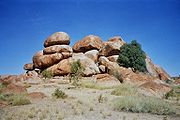
Kaytetye
Encyclopedia

Indigenous Australians
Indigenous Australians are the original inhabitants of the Australian continent and nearby islands. The Aboriginal Indigenous Australians migrated from the Indian continent around 75,000 to 100,000 years ago....
who live around Barrow Creek and Tennant Creek in the Northern Territory
Northern Territory
The Northern Territory is a federal territory of Australia, occupying much of the centre of the mainland continent, as well as the central northern regions...
. Their neighbours to the east are the Alyawarre
Alyawarre
Alyawarre are an Indigenous Australian people, or language group, from the Northern Territory.In 1980 they lodged a land claim with the Wakaya people, which was handed back to them on 22 October 1992. The size of the land was 2065 km²....
, to the south the Anmatyerre
Anmatyerre
Anmatyerr, are an Indigenous Australian people, or language group, from the Northern Territory. They are from an area near Arnka , Arwerlt Atwaty Anmatyerr, are an Indigenous Australian people, or language group, from the Northern Territory. They are from an area near Arnka (Mount Leichhardt),...
, to the west the Warlpiri
Warlpiri
The Warlpiri are a group of Indigenous Australians, many of whom speak the Warlpiri language. There are 5,000–6,000 Warlpiri, living mostly in a few towns and settlements scattered through their traditional land in Australia's Northern Territory, north and west of Alice Springs...
, and to the north the Warumungu
Warumungu
The Warumungu are a group of Indigenous Australians, many of whom speak Kriol or the Pama–Nyungan language of Warumungu. They inhabit the region of Tennant Creek and Alice Springs in the Northern Territory of Australia as well as small towns to the South.- History :In the 1870s, early white...
.
The Devils Marbles, which the Kaytetye call Karlu Karlu, are located on a sacred Dreaming
Dreaming (spirituality)
The Dreaming is a common term within the animist creation narrative of indigenous Australians for a personal, or group, creation and for what may be understood as the "timeless time" of formative creation and perpetual creating....
site. The Kaytetye believe the boulders are the eggs of the rainbow serpent
Rainbow Serpent
The Rainbow Serpent is a common motif in the art and mythology of Aboriginal Australia. It is named for the snake-like meandering of water across a landscape and the colour spectrum caused when sunlight strikes water at an appropriate angle relative to the observer.The Rainbow Serpent is seen as...
, who passed through the area in the Dreamtime
Dreamtime
In the animist framework of Australian Aboriginal mythology, The Dreaming is a sacred era in which ancestral Totemic Spirit Beings formed The Creation.-The Dreaming of the Aboriginal times:...
.
The Kaytetye language, like many Indigenous languages in this part of Central Australia
Central Australia
Central Australia/Alice Springs Region is one of the five regions in the Northern Territory. The term Central Australia is used to describe an area centred on Alice Springs in Australia. It is sometimes referred to as Centralia; likewise the people of the area are sometimes called Centralians...
, is an Arandic language
Arandic languages
Arandic is a small family of Australian Aboriginal languages, consisting of two dialect clusters, Arrernte and Kaytetye. Dixon had cast doubt on the validity of the grouping, but it was demonstrated with the comparative method by Koch ....
. A sophisticated form of sign language
Australian Aboriginal sign languages
Many Australian Aboriginal cultures have or traditionally had a manually coded language, a sign-language counterpart of their spoken language. This appears to be connected with various speech taboos between certain kin or at particular times, such as during a mourning period for women or during...
is also used by some Kaytetye.
Kaytetye call the area around Barrow Creek Thangkenharenge.
Conflict between the Kaytetye and European settlers sometimes took violent form. There were revenge killings by settlers of Kayetye at Barrow Creek in 1874. In the Coniston massacre
Coniston massacre
The Coniston massacre, which took place from 14 August to 18 October 1928 near the Coniston cattle station, Northern Territory, Australia, was the last known massacre of Indigenous Australians. People of the Warlpiri, Anmatyerre and Kaytetye groups were killed...
of 1928, settlers killed Kaytetye.
Alternative spellings for Kaytetye include Kartetye, Kartiji, Kaytej, Keytej and Katish.
External links
- "Barrow Creek", Central Land Council

